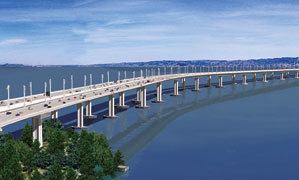 |
 |
| Switched at Birth? Viaduct (top) may replace SAS design. (Photos courtesy of Caltrans) |
But the plan faces opposition from Bay Area residents and from skeptical state lawmakers, who must approve a new design and funding when the Democrat-controlled legislature returns next month. It will examine the California Dept. of Transportations argument that switching to a conventional concrete segmental box girder design will gain promised cost savings and enable completion by 2012, the original date for finishing the self-anchored suspension span. Observers hint that the move may also be a way to force Bay Area politicians to provide more funding if they want the signature span design.  Click here to view graph
Click here to view graph
The Dec. 10 announcement by Sunne Wright McPeak, California secretary of business, transportation and housing, caps a tumultuous year for the project. The state spent the summer weighing the single $1.4-billion bid, nearly twice Caltrans estimate, submitted by a team of American Bridge Co., Coraopolis, Pa.; Japans Nippon Steel Bridge; and Fluor Enterprises, Aliso Viejo, Calif. (ENR 10/11 p. 10). The state declined the contract after the legislature did not approve funding by the Sept. 30 deadline.
Contractors, state officials and other observers note the unusually complex and challenging design of the new span, the first asymmetrical SAS bridge in the U.S. and the largest of its kind in the world. "Its just an unconventional bridge type to build, versus a very common" type, the concrete viaduct, says Dan McElhinney, head of Caltrans toll bridge construction program. East span designer, San Francisco-based T.Y. Lin International, declined comment. McElhinney says the firm may be involved in redesign, but says the agency is keeping its options open.
The high bid presented Caltrans with the dilemma of proceeding with a fully vetted design despite budget problems, or switching to the simpler and more common segmental box girder that could save money but would require additional design and environmental review. After hearing from advisers, including bridge contractors and engineers, the Federal Highway Administration, state and federal agencies, and blue-ribbon committees, Caltrans recommended two choices to Schwarzeneggereither extend the viaduct or rebid the SAS design.
But the state also bypassed some recommendations. A panel that counseled rejecting the $1.4-billion bid suggested a switch to a cable-stayed bridge. Thomas R. Warne, its chairman and former director of the Utah Dept. of Transportation, says that option offered the best chance to save money, achieve the 2012 completion and minimize environmental impact. He says his panel did not consider a viaduct because additional foundations would create environmental issues and offer less savings.
|
But a Caltrans seismic safety peer review panel "cautions about premature conclusions from studies presented to date." The panel expressed concern "that delays in the execution of the signature span for the new Bay Bridge will increase seismic exposure and risk."
Bob Luffy, CEO of unsuccessful bidder American Bridge, takes issue with the change. "What is missed here, at least by the governors office...is that site conditions and the criteria under which SAS was designed, were the reason for the cost of the structure." The design, he argues, went through "a 20-month bidding process under which everything was scrutinized to the Nth degree."
Despite an apparently simpler design, the viaduct has other complications. McElhinney says Caltrans has not suspended the $175-million foundation contract held by a Kiewit Pacific-led team but could still cancel it if the foundation design is incompatible with the viaduct. It also might not expand competition.
"Without some unusual contract bidding process, there is probably only one bidder interested in the Skyway extension work: the current Skyway contractor," Caltrans report says.
tuck between a rock and a hard place, California is taking the extraordinary step of discarding the signature design for a self-anchored suspension bridge on the San Francisco-Oakland Bay Bridges east span. In a move the state hopes will save up to $500 million, Gov. Arnold Schwarzenegger (R) wants to substitute an extension of a concrete viaduct similar to the adjacent 1.1-mile-long "Skyway," now 65% complete.